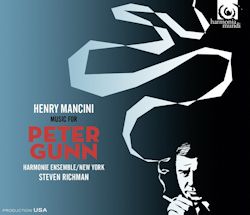Harmonie Ensemble, New York/Steven Richman
rec. June 2012, DiMenna Center for Classical Music, NYC
[51:06]
Steven Richman and the Harmonie Ensemble/New York have a fine track record. Their album of original Gershwin and Grofé orchestrations and arrangements, and
their Ellington and Strayhorn Nutcracker Suite disc alerted the listener to two things: archival curiosity and executant authority. Together this
makes for a well-nigh unarguable force. Now they turn their focus on what is superficially at any rate a less easy project – Henry Mancini’s music for the
1958 TV detective series Peter Gunn. The soundtrack of the three-year series has elements of contemporary jazz with the scoring beginning as
incidental or accompaniment music and gradually developing to such an extent that toward the end of the 114 episodes it had become an integral part of the
show.
Most people will know the Peter Gunn theme, which has often been hammed up by bands. But many won’t know that the inspiration for the music in the episodes
was what could best be called ‘West Coast Polite’, cooler even than Cool. Mancini was also inspired by Ellingtonian voicings, by Goodman or Shaw themes and
by the Kansas City lope of Basie. Block chords reminiscent of George Shearing can also be heard.
If this is, largely, pop-jazz, it’s pop-jazz with a vengeance. The famous theme itself is brilliantly delivered, and no wonder when the band personnel
includes some luminaries as Lew Tabackin, Ronnie Cuber, Lew Soloff, powered by drummer Victor Lewis. In point of fact the ensemble sports five saxes, four
trumpets, four French Horns, four trombones, and a five-man rhythm section of guitar, vibes, piano, bass and drums. It gives the sound an especially
pungent and dark-brown texture, though one ever lightened by the West Coast ethos which favoured a kind of bright fluidity. Each of the 16-tracks, which
includes the theme reprise, has things of interest and since no cut breaks four minutes in length points have to be made succinctly and development is
always at a premium.
The Brothers Go to Mother’s
is very West Coast, Dreamsville sounds – and is – Ellingtonian, Session at Pete’s Pad Goodmanesque. Soft Sounds opens with
Lionel Hampton-like vibes and there are fine solos all-round on the loping bass-infused Fallout. Slow and Easy is, indeed, a slow blues
but it’s more mood music than really bluesy whilst A Profound Gass shows how Mancini used scene-setting music to great effect. Blue Steel
offers an exciting chase sequence with brassy outbursts and some brilliant articulation from the band, which really does summon up the ethos well. On Blues for Mother’s we hear an alto solo that pays homage to Johnny Hodges’s legato richness. Spook has a big boogie backbeat with a full
complement of raunch. If you’re not stirred by now, Peter Gunn is clearly not for you.
It most definitely is for me. These are outstanding recreations played by top pros bringing the music – not all top quality jazz, but who cares –
triumphantly to life.
Jonathan Woolf
